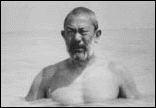|
|
 |
Production Company: UMI Eiga Producer, Director,Scriptwriter: Oshige Jun 'ichiro Photography: Hotta Yasuhiro Sound: Ichikawa Fumitake Assistance: Tanaka Minoru, Ebihara Hideki, Ikeuchi Masaya, Higa Yukio, Uechi Kanko, RBC, JSP, ITEX Appearance: Kamijo Tsunehiko 1996 / Color / 16mm / 60 min |
| Oshige Jun'ichiro is known for his independent production Kurokami ("Kurokami," 1970) and for his documentation of Oshima Nagisa's visit to Ogawa Shinsuke at a small ranching village in A Visit to Ogawa Productions ("Ogawa puro homonki," 1981). A resident of Kobe, Oshige lived through the Great Hanshin-Awaji Earthquake, experiencing firsthand the forceful majesty of "Nature" and of life. Whilst touring some Okinawan islands in 1983, he came across one that was unpopulated. Oshige then tried to capture on film the awesome feeling that the island generated. Editing independently shot footage, he completed two films, Island of Wind ("Kaze no shima"), where he documents the restoration of earthenware relics, and Island of Light. The latter film's motif centers around something that Oshige's mother once told him. Indeed, this piece is not one in which Oshige investigates or explores a tangible subject, but rather one about a global Nature, one that tries to grab hold of the director's own attitudes towards nature and of the invisible "sense" that can be gained from the coral reef. The film begins with the image of a naked man suddenly emerging from out of the water. While that role is played by Kamijo Tsunehiko, no one would doubt that he is actually portraying Oshige himself. Sometimes when Kamijo Tsunehiko appears on the screen, all we see are his eyes; he attempts no action whatsoever. And to parallel the visual track, Oshige gives us what might be the surviving sounds of those people who are thought to have once lived on this typical, now solitary, isle in the southern seas. For the voice of this lost civilization Oshige presents to us the voices of children playing in an urban park, as well as music varying from Okinawan folk songs to saxophone solos. Here, through these images of Nature, the spectator knows that Oshige's personal recollections are infinite. |